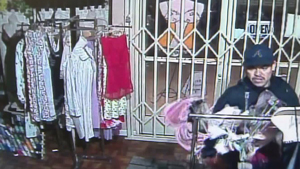Police called him the “Panty Bandit,” a serial burglar who targeted nearly a dozen lingerie retailers and sex shops in the San Fernando Valley – some of them for multiple break-ins – during an eight-month crime spree that began in January. Security footage showed a mustached man lifting thousands of dollars in underwear from stores, leaving a trail of shattered windows, broken doors and frightened business-owners in his wake. “We beefed up our security system, but past that, there wasn’t much we could do,” said one store manager who requested anonymity. The shop where she works was hit twice in just a few months. The bandit’s rampage came to an end Sept. 29 when he was apprehended by officers with the Topanga division of the Los Angeles Police Department outside adult entertainment boutique Excitement at 19841 Ventura Blvd. in Woodland Hills. By the time of his arrest, 35-year-old Carlos Olivas allegedly stole more than $10,000 in merchandise from victimized stores, said police, including wares from Intimate Image, which specializes in bras for mastectomy patients, and Les Corset Lingerie, a seller of luxury European undergarments. He was booked for commercial burglary and his bail was set at more than $200,000, according to police. While retailers can breathe a bit easier with the panty bandit behind bars, Capt. Paul Vernon, patrol captain at the Topanga Police Station, warned that commercial theft is a growing threat to local businesses. In the Topanga area, property crime as a whole – including burglary, car break-ins, vehicle theft and larceny – has spiked more than 8 percent since last year and more than 20 percent since 2014, according to LAPD data. For theft alone, the figure rises to 63 percent. Of course, certain neighborhoods have more commercial crime than others; the area around the Westfield Topanga Mall and Fry’s Electronics Inc. accounts for a fifth of all area crime, according to Vernon. The store manager said that while her shop has recovered from the burglaries, she remains wary that more will follow. “After two weeks, the police stop coming around because they’re working on the investigation,” she said. “You’re left to fend for yourself and hope for the best. … At least we know what to do if something happens again.” On the night Olivas was captured, police responded to another burglary at the Westfield Topanga location of apparel retailer Hollister Co., the LAPD said. Police apprehended suspect Marco Naranjo, 21, about a mile away. Most of his spoils had already been sold to a local “fence,” or brokerage for stolen goods. Naranjo had the remaining Hollister loot with him when he was caught, police said. They found him with a needle in his arm, already shooting the heroin he had purchased with his spoils. “Ninety-five or maybe even 98 percent of all the people we arrest related to this kind of stuff have drug habits to support,” Vernon said. “These two guys reflect just a small bit of the amount of retail crime that goes on here.” Widespread narcotic addiction is at the core of the issue, he said, but laws enacted under Proposition 47 and subsequent legislation have contributed to the problem. Billed as an effort to reduce state prison and county jail populations by downgrading some nonviolent felonies to misdemeanors, Proposition 47 has released thousands of inmates since it was enacted in 2014, according to the Public Policy Institute of California. While some have managed to build productive lives, others did not receive rehabilitation to prevent them from returning to substance abuse. As narcotics arrests have dropped, property crime throughout Los Angeles – and the state – has risen, based on data provided by the LAPD and the policy institute. In contrast, the rate of property crime nationwide has fallen since 2014, according to the FBI. Yet the consequences of state legislation are only part of the problem. In the few cases unrelated to drugs, Vernon explained, commercial theft is run by a larger operation. The black market regions in Syria and Venezuela offer lucrative prices for clothing and baby formula, for example. Those with the means will pay exorbitant amounts to have them, offering a windfall for commercial criminals. “Their only overhead is shipping costs, because they’re stealing it all,” he said. But a significant amount of merchandise stolen from local businesses winds up crossing freeways rather than borders. Vernon recalled a recent case in which lingerie stolen from a Topanga Victoria’s Secret by two local women was traced to a fence in South Los Angeles. Authorities who followed them were astounded by what they discovered. “There was around $90,000 worth of merchandise in our area – just from our area!” Vernon said. “Some of it from Victoria’s Secret, some of it from other stores.” What can retailers do to protect themselves? Alarms and security cameras are a good place to start, but layout goes a long way. Lingerie – commonly stolen because of its small size and high value – should be displayed within employees’ line of sight. Outsmarting would-be criminals takes creativity, too. “If you’re going to have a clothes rack with hangers, alternate them,” Vernon said. “That way, if someone tries to pull them off the rack all at once, they’ll just pull the whole thing down.”
